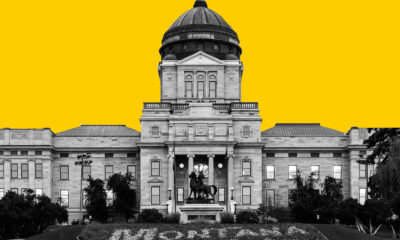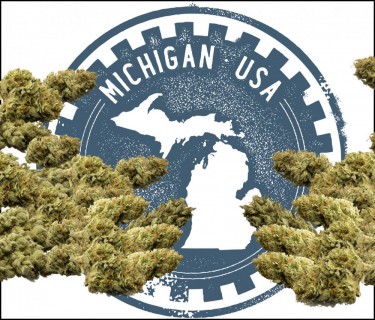Cannabis News
Donald the Delusional and His Views on Genetically Engineered Cannabis Causing Violence in America
Published
2 years agoon
By
admin

Donald the Delusional and his views on Genetically Engineered Cannabis
Donald Trump, aka “The Donald,” is the epitome of bizarreness in American politics. He’s the guy who singlehandedly flipped the switch on the level of crazy, forever unveiling the absurdity of the system.
He’s activated some sort of a “backdoor program” in the minds of millions, convincing them that he’s some sort of hero or savior against an evil government. Don’t get me wrong, the government is fucking evil, but Trump is not the guy to do anything about it. He’s a rogue agent, yes, but still a part of the system and gaming it like all the rest of them.
Now, let’s talk about the latest absurdity that is Donald Trump and his claims that genetically modified cannabis is responsible for the mass murders in the United States.
Yes, you read that right. Trump seems to think that weed, which has been used by humans for thousands of years, is suddenly the culprit behind the rise in violence. It’s as if he’s living in some sort of alternate universe where facts don’t matter, and his own personal beliefs reign supreme.
To support this claim, Trump pointed to a news article that reported on a man who allegedly smoked a joint laced with “super-strong stuff” before killing his family.
But here’s the thing: there’s no evidence to suggest that the weed he smoked was genetically modified or in any way different from what’s been available on the black market for decades.
In fact, most scientists agree that genetic engineering of cannabis is still in its infancy and there’s no evidence to suggest that it has any impact on human behavior.
Trump’s claims are not only unfounded, but also dangerous. It echoes a claim that was done by early prohibitionists such as Anslinger, DuPont and Heart. They wrote about sensationalist stories of people killing their families with an axe for smoking some doobies. Except, the person who actually killed their family with an axe was a psychotic mentally unstable person with delusional paranoia – similar to “The Donald”.
By spreading lies about the effects of marijuana, he’s fueling the stigma against it and contributing to the ongoing war on drugs. It’s time for our “leaders” , a term I use loosely – to start basing their claims on facts and evidence, instead of fear-mongering and personal beliefs.
In a speech at a National Rifle Association (NRA) leadership forum on Friday, former President Donald Trump made several controversial and unproven claims. He suggested that psychiatric drugs, transgender hormone treatments and ideology, genetically engineered cannabis, and other narcotics may be causing mass shootings in the country by leading to psychotic breaks that result in gun violence.
Now don’t get me wrong, I too have theories about the effects of Psychiatric Medication on the formation of young and developing brains. As this is a claim often used to deter people from using cannabis or other drugs – yet when it comes to Ritalin, Clonapil, or these other psychiatric drugs – we don’t hear a peep.
Whether there’s a connection between transgender hormone treatments or other narcotics – I don’t think this is accurate.
While it’s true that psychotic breaks definitely plays a role in mass shootings, since no sane person will commit mass murder in such a blatantly insane manner. But these are not “causes”.
Trump stated that he would direct the Food and Drug Administration (FDA) to investigate these factors as possible causes of mass shootings. He also mentioned that he would have the FDA convene an independent outside panel to investigate his theory. And that’s what it is, “his theory”.
Trump dismissed the idea that mass shootings are a gun problem and instead called it a mental health, social, cultural, and spiritual problem.
Don’t get me wrong, I don’t think it’s a gun problem either. I do agree that it’s about mental health, social and cultural and even spiritual issues. Mass shootings is a symptom of a system that crushes the individual’s soul.
Back in the day, we used to call it “Going Postal” – because postal workers were having psychotic breaks as a result of the relentless grind of the system. These days, kids are being introduced to streams of infinite bullshit telling them that everyone else is better and happier than they are.
Mass Shootings is the “Going Postal of our times”.
While Trump did not pursue a full-scale crackdown of state-legal cannabis programs as president, he did make several hostile anti-marijuana actions. These included rescinding Obama-era guidance on cannabis prosecutions and implementing policies that made immigrants ineligible for citizenship if they consumed marijuana or worked in the cannabis industry.
At the NRA event, Trump’s perspective on marijuana took on a conspiratorial new tone, echoing points made by author Alex Berenson. However, it is not clear what he meant by “genetically engineered” marijuana. It is possible that he is referring to concerns about high-potency THC cannabis products. And high potency isn’t “genetically engineered”. It’s selectively bred. Like the way you get a Labradoodle.
I wouldn’t call it “genetic engineering” more as a form of eugenics – but in plants. This is not new, because if these “genetic alterations” were to be the reason – then all of the genetically engineered corn Americans eat is turning them into monsters. But of course, the Corn industry wouldn’t like you to think about that.
Trump’s comments are likely to alienate parts of his base that have held out hope he would lead the charge on ending cannabis prohibition. While Republicans are less likely to support cannabis legalization compared to Democrats and independents, the issue has become increasingly bipartisan.
The fact of the matter is that Trump is simply saying shit to please those who are listening, in this case the NRA.
In the world of cannabis cultivation, there are two terms that are often used interchangeably: “genetic engineering” and “selective breeding.” While both of these methods are used to produce desirable traits in cannabis plants, they are fundamentally different in nature.
Selective breeding is the process of intentionally breeding plants with desirable traits in order to produce offspring with those same traits. This is a practice that has been used in agriculture for centuries, and it involves selecting the best plants from a crop and breeding them with each other to create a new generation of plants that inherit those desirable traits.
For cannabis cultivators, selective breeding means carefully choosing which plants to breed based on traits like yield, potency, flavor, and aroma. This can involve selecting plants that are naturally resistant to pests or diseases, or choosing plants with a specific cannabinoid profile.
Genetic engineering, on the other hand, involves altering the genetic makeup of a plant using biotechnology. This can include introducing new genes into a plant’s DNA or altering existing genes in order to produce specific traits.
While genetic engineering has been used in other crops to create desirable traits like resistance to pests or drought, it is not currently used in the cannabis industry due to legal restrictions. In fact, most cannabis cultivators rely on selective breeding to produce the plants they want.
One of the main differences between selective breeding and genetic engineering is that selective breeding is a natural process that relies on the inherent variability of a plant’s genetic makeup, while genetic engineering is an artificial process that involves manipulating genes in a laboratory.
Another difference is that selective breeding allows for a degree of unpredictability in the resulting plants, as the combination of genes from two parent plants can create unexpected traits in their offspring. Genetic engineering, on the other hand, is a precise process that allows for more control over the resulting traits.
In the cannabis industry, there is often confusion around these two concepts, with some people mistakenly using the term “genetic engineering” to refer to selective breeding. However, it is important to understand the difference between these two methods in order to have a clear understanding of how cannabis plants are produced.
While both selective breeding and genetic engineering are used in agriculture to produce desirable traits in plants, they are fundamentally different methods.
Selective breeding is a natural process that relies on the inherent variability of a plant’s genetic makeup, while genetic engineering is an artificial process that involves manipulating genes in a laboratory. In the cannabis industry, selective breeding is the primary method used to produce desirable traits in plants, and genetic engineering is not currently used due to legal restrictions.
And it’s because of these differences that I know that Trump is full of shit. The fact of the matter is that he’s only using certain buzz words to get people to write about the stupid shit that comes out of his mouth.
My Plea to Americans
My plea to Americans is simple: don’t insult your own intelligence by electing either Biden or Trump in 2024. These two individuals are the epitome of what’s wrong with American politics. They are nothing but parasites who feed off of your hard work and sacrifice. They will take everything you hold dear – your freedom, your security, your money – and sell it to their corporate donors and sponsors.
The sad truth is that both Trump and Biden represent everyone but you. They are not leaders who care about the well-being of the American people. Instead, they care only about their own power and enrichment. They are not interested in creating a better America for all of us. They are interested in protecting their own interests and the interests of their cronies.
If you vote for either of these individuals, you are selling your own integrity. You are saying that you are okay with being used as a product by these politicians. You are saying that you are okay with them taking everything you have worked for and giving it away to their rich friends.
It’s time to wake up and realize that this is all a game rigged against you. Don’t follow the tribe in the upcoming election. Follow your heart. Don’t listen to the lies of the rich bastards who want to sell you a cheap story in exchange for all your power.
Psychopaths are ruling us all. We need to take back our power and start electing leaders who truly care about the American people. We need leaders who will fight for our freedom, our security, and our prosperity. We need leaders who will put the interests of the American people above their own.
So, my plea to Americans is this: don’t be fooled by the empty promises of politicians who don’t care about you. Don’t vote for Trump or Biden. Vote for someone who truly represents your values and your interests. Vote for someone who will fight for a better America – not just for the rich and powerful, but for all of us.
The future of America is in your hands. Don’t waste your vote on someone who will only take advantage of you. Vote for a leader who will truly make a difference in your life and the lives of your fellow Americans. It’s time to take back our power and create a brighter future for ourselves and for future generations.
WHY WE SHOULD LEGALIZE WEED EVEN IF TRUMP IS RIGHT, READ ON…
WHY WE SHOULD LEGALIZE WEED EVEN IF ANTI-POT GROUPS ARE RIGHT!
You may like
-


Trump research cuts threaten cannabis studies, poses rescheduling questions
-


Cocaine Hub Seized by Rebels, Thwarting Colombia’s ‘Total Peace’
-


SEO for Cannabis? – How to Build Top Rankings for Your Cannabis Brands in 2025
-


Montanans must activate to protect legalization in 2025
-


Analysis: Don’t hold your breath for legalization under Trump 2.0
-


Pot for Potholes? – Michigan Plans to Let Cannabis Tax Revenue Fix the Growing Pothole Problem in the State
Cannabis News
SEO for Cannabis? – How to Build Top Rankings for Your Cannabis Brands in 2025
Published
22 hours agoon
February 26, 2025By
admin

How to Cannabis SEO in 2025 like a Pro!
Running a cannabis brand online is like trying to play Monopoly with one hand tied behind your back while the banker keeps changing the rules. Trust me, I’ve been in this game long enough to know the frustrations. You can’t advertise on Facebook, Instagram treats you like a digital pariah, and Google Ads? Forget about it. One wrong move and poof – your social media accounts vanish faster than a fresh batch of edibles at a music festival.
But here’s the kicker: while traditional advertising channels remain firmly closed to our industry, there’s one path that’s still wide open – organic search traffic. That’s right, I’m talking about SEO (Search Engine Optimization), the art and science of getting your website to show up when people search for cannabis-related content.
Now, I know what you’re thinking. “But Reg, how am I supposed to compete with giants like Marijuana.com who’ve been hoarding prime keyword real estate since before some of us were born?” Well, my friend, this is where things get interesting. You see, while the big players might have a stranglehold on broad terms like “marijuana” and “cannabis,” there’s a whole world of untapped potential in long-tail keywords and niche topics.
The challenge isn’t just about showing up in search results – it’s about showing up in front of the right people. And let’s be honest, if you’re not on the first page of Google, you might as well be selling oregano in a dark alley. The drop-off rate from page one to page two is steeper than that time I tried to explain terpenes to my grandmother.
But fear not! Today, I’m going to share something that could be a game-changer for smaller cannabis brands operating on a shoestring budget: how to leverage artificial intelligence for SEO. That’s right – we’re going to turn the tables on our corporate overlords by using their own tools against them.
So grab your favorite strain, settle in, and let’s dive into how AI can help level the playing field in the cannabis industry’s digital landscape.
Alright, before we dive into the wonderful world of AI-powered cannabis SEO, we need to get our fundamentals straight. Think of SEO as a digital game of hide and seek, except you’re trying to help Google find you while playing by an ever-changing set of rules.
Let’s start with the basics. Meta tags are like the ingredients list on your favorite edible – they tell search engines what your content is about. These include your title tags (what shows up in search results), meta descriptions (that little preview text), and headers (those H1s, H2s, etc. that break up your content). Keywords are the specific terms you want to rank for, while long-tail keywords are more specific phrases – think “best organic CBD oil for anxiety” versus just “CBD oil.”
Now, here’s where many cannabis brands get it wrong – they stuff their content with keywords like a rookie packing their first bowl. “Cannabis dispensary near me cannabis products buy cannabis cannabis deals cannabis cannabis cannabis…” You get the idea. This is what we call “black hat” SEO, and let me tell you, Google hates this more than the DEA hates fun. Pull this stunt, and your site might disappear from search results faster than your stash during a drought.
There’s a crucial difference between organic keyword ranking and paid advertising. Organic ranking is like growing your own – it takes time, patience, and proper care, but the results are worth it. Paid advertising (which isn’t available to cannabis brands anyway) is like buying from a dispensary – quick results but costly. Since we’re locked out of paid channels, organic is our best friend.
Remember this golden rule: while you’re optimizing for search engines, you’re writing for humans. Your content needs to be the digital equivalent of premium flower – high quality, well-cured, and delivering real value. Think of your website as a budtender who needs to both attract customers and keep them coming back.
Google tracks various metrics to determine your site’s quality. Time on page (how long visitors stick around) is like customer retention at a dispensary. Bounce rate (how quickly people leave) is like customers walking out without buying anything. Click-through rate (how many people click your link in search results) is like foot traffic. All these metrics tell Google whether your content is worth recommending to others.
The tricky part? Google’s algorithm is more mysterious than your dealer’s “special” strain. It uses over 200 ranking factors, and they change more often than dispensary daily specials. But one thing remains constant: quality content that serves user intent will always win in the long run.
Now that we’ve covered the fundamentals, let’s talk about crafting an SEO strategy specifically for cannabis brands. Because in this industry, we’re not just competing with other businesses – we’re fighting against decades of stigma, restrictive policies, and platforms that treat us like we’re selling contraband instead of a legal product.
Listen up, cannabis entrepreneurs – before you start throwing keywords around like confetti at a dispensary grand opening, you need to understand exactly who you’re trying to reach. And I’m not talking about some vague notion of “people who like weed.” We need to get specific.
Enter the buyer persona – your ideal customer’s digital avatar. Let me give you an example: Meet “Mindful Michelle,” a 35-year-old yoga instructor who uses cannabis to manage anxiety and enhance her meditation practice. She’s health-conscious, researches products thoroughly before buying, and values organic, sustainably produced cannabis. She shops primarily at boutique dispensaries and follows wellness influencers on Instagram. Her annual income is $65,000, and she’s willing to pay premium prices for quality products.
See what I did there? We’ve created a detailed profile that helps us understand not just who our customer is, but how they think and what they’re looking for. This brings us to user intent – the holy grail of SEO strategy.
Let’s say Michelle is looking for information about CBD for anxiety. She might start with a broad search like “CBD for anxiety,” but as she learns more, her searches become more specific. She might eventually search for “organic full-spectrum CBD oil dosage for meditation” – that’s a long-tail keyword gold mine right there. Why? Because it shows high intent (she’s looking for specific information), and there’s likely less competition for this precise phrase than broader terms.
When crafting content around these keywords, you’ll want to follow some best practices:
-
Use your target keyword in the title (naturally, not forced)
-
Include it in the first 50 words of your content
-
Sprinkle related terms throughout (think “anxiety relief,” “mindfulness,” “natural remedy”)
-
Include outbound links to reputable sources (like scientific studies)
-
Create internal links to your other relevant content
-
Use header tags (H1, H2, H3) to structure your content logically
But here’s the thing about content length – Google loves comprehensive content that thoroughly addresses user questions. We’re talking 1,500+ words for main pages and blog posts. “But Reg,” you might say, “isn’t that a bit much?” Not if you’re actually solving problems and providing value.
Think about it this way: if Michelle lands on your page about CBD and anxiety, and you’ve got a thorough, well-researched article that addresses dosing, different consumption methods, potential interactions, and the science behind how CBD affects anxiety – she’s likely to stick around. More importantly, she’s likely to bookmark your site and come back when she’s ready to make a purchase.
This is how you build trust in the cannabis space – by becoming a reliable source of information first, and a seller second. Remember, in an industry where traditional advertising is restricted, your content needs to work twice as hard.
Now, I know what you’re thinking – “Reg, this sounds like a lot of work!” And you’re right. Creating comprehensive, SEO-optimized content that actually provides value is no small task. But that’s where our AI friends come in handy. Let me show you how to make this process a whole lot easier…
Alright, my cannabis-loving friends, it’s time to unleash the robots! Not the terrifying kind that might take over the world, but the helpful ones that’ll make your SEO efforts smoother than a well-cured top shelf bud.
Let me tell you, creating high-quality, media-rich content used to be harder than explaining terpenes to your grandma. You’d need a writer, photographer, graphic designer, video editor – the works. But now? We’ve got an entire digital army at our disposal, and it’s surprisingly affordable.
Here’s my tried-and-true workflow that’ll have you pumping out content faster than a hydroponic setup on steroids:
First stop: Perplexity.AI. This bad boy is like having a research assistant who never sleeps and actually remembers everything they read. Feed it your topic, and it’ll spit out relevant scientific studies, market research, and questions you wouldn’t have thought to ask. Want to write about CBD and sleep? It’ll dig up everything from clinical trials to user demographics.
Next, slide into your favorite AI chatbot – whether that’s ChatGPT, Claude, or Grok. If you’re feeling fancy, hit up Openrouter and sample them all like you’re at a cannabis cup. These tools will help you craft content that’s more engaging than your local budtender’s strain recommendations. (I could write a whole article just on prompt engineering, but that’s a story for another day.)
Now, here’s where it gets fun. Need images? Leonardo.ai or MidJourney are your new best friends. Want a stunning visual of cannabinoids interacting with neural receptors? Or maybe a chill lifestyle shot of someone enjoying their evening routine? These AI tools can create custom, copyright-free images that look better than most stock photos. Pro tip: Have your AI writing assistant generate image prompts based on your article – it’s like having a creative director in your pocket.
But why stop at text and images? Let’s get audio in the mix with Elevenlabs. Turn your article into a podcast-style recording that people can listen to during their commute. Then, take those AI-generated images, throw them into Capcut with your audio, and boom – you’ve got a video ready for YouTube. That’s three different ways for people to consume your content, and three different chances to keep them engaged.
Here’s the real kicker – you can “spin” your article (that’s industry speak for rewriting while maintaining the core message) a few times and publish it on platforms like Substack, Medium, or Reddit. Link these back to your original piece, and you’re building a web of high-authority backlinks that’ll make Google happier than a kid in a candy store.
The best part? This entire process takes about 2-3 hours once you get the hang of it. You’re creating a content ecosystem that provides value across multiple platforms and formats, all while building those precious SEO signals that Google loves.
Remember though, always keep your target keywords in mind throughout this process. Have your AI assistants strategically place them in your content, headers, and meta descriptions. It’s like leaving a trail of breadcrumbs that leads straight to your website.
And this, my friends, is just scratching the surface. The robots are here to help, and they’re making premium content creation more accessible than ever. Time to embrace the future and let AI help you climb those search rankings!
What I’ve shared here is just the tip of the cannabis cola, if you will. It’s like I’ve taught you how to pack a bowl, but there’s still so much to learn about the whole grow operation. However, these fundamentals should be enough to get you started on your SEO journey.
Here’s the deal: aim to post 2-3 solid pieces of content each week. And I mean solid – not that schwag content that’s just recycled from other sites. We’re talking premium, home-grown content that your users will actually want to consume. Share it across your social platforms (where allowed, of course – we all know how touchy these platforms can be about cannabis content), and weave your products or services into the narrative naturally. Nobody likes a pushy salesperson, but everyone appreciates genuine expertise and helpful advice.
Think of it like growing a healthy cannabis plant – you need consistent care, the right nutrients, and most importantly, patience. Keep feeding your audience valuable content, and they’ll reward you with engagement. When Google sees users spending time on your site, sharing your content, and coming back for more, it’s like getting a five-star review from the most important dispensary rating system in the digital world.
Remember, success in cannabis SEO isn’t about gaming the system – it’s about actually being useful to your target audience. Solve their problems, answer their questions, and become their trusted source of information. Do this consistently, and Google will naturally want to recommend you to others searching for similar content.
And here’s a final nugget of wisdom: the cannabis industry is constantly evolving, and so should your SEO strategy. Stay curious, keep testing new approaches, and don’t be afraid to experiment with different content formats and topics.
Now get out there and start creating some killer content. Your future customers are out there searching for you – it’s time to help them find you.
Good luck, and may your rankings be high and your bounce rates low!
https://www.reddit.com/r/weedbiz/comments/1ig1nwq/why_are_most
_cannabis_seo_agencies_scams_anyone/
CANNABIS SEO GOES HIGH TECH, READ ON…
Cannabis News
Pot for Potholes? – Michigan Plans to Let Cannabis Tax Revenue Fix the Growing Pothole Problem in the State
Published
2 days agoon
February 25, 2025By
admin

In recent months, Michigan has found itself at the intersection of two significant issues: the deteriorating state of its roads and the burgeoning cannabis industry. Governor Gretchen Whitmer’s ambitious plan to allocate funds from marijuana taxes to repair potholes has ignited a lively debate within both the political and cannabis communities. As the state grapples with aging infrastructure, the proposal raises questions about funding priorities, industry sustainability, and consumer impact. This article delves into the details of the plan, its implications for Michigan’s cannabis sector, and the broader conversation it has sparked.
The State of Michigan’s Roads
Michigan is notorious for its rough roads. According to a report from the American Society of Civil Engineers, nearly 40% of Michigan’s roads are in poor condition, leading to increased vehicle damage and safety concerns for drivers. The state has long struggled with funding for road repairs, often relying on gas taxes and federal funds that have proven insufficient to address the growing backlog of maintenance needs.
The Economic Impact of Poor Infrastructure
The economic ramifications of poor road conditions are profound. Businesses face higher transportation costs due to vehicle wear and tear, while residents experience longer commute times and reduced quality of life. Additionally, inadequate infrastructure can deter new businesses from setting up shop in Michigan, further stifling economic growth.
Governor Whitmer’s Proposal
In response to these pressing issues, Governor Whitmer announced a comprehensive $3 billion plan aimed at revitalizing Michigan’s roads. The proposal focuses on innovative funding strategies, including a significant increase in taxes on marijuana products.
Funding Breakdown
The proposed funding plan includes:
-
$1.7 billion from corporate taxes and technology companies.
-
$1.2 billion from increased gas taxes.
-
$500 million cut from unspecified spending areas.
-
A 32% wholesale tax on marijuana products projected to generate $470 million annually.
This ambitious approach aims not only to repair potholes but also to create a more sustainable funding model for ongoing infrastructure needs.
The Role of Cannabis Tax Revenue
Michigan legalized recreational marijuana in 2018, leading to a rapid expansion of the cannabis market. With over 400 licensed dispensaries and a thriving cultivation sector, tax revenue from cannabis sales has become a significant source of income for the state. Currently, marijuana products are subject to a 10% excise tax and a 6% sales tax; however, Governor Whitmer’s proposal seeks to elevate this wholesale tax substantially.
Reactions from the Cannabis Community
The announcement has elicited mixed reactions from various stakeholders within Michigan’s cannabis community. While some applaud the idea of using cannabis tax revenue for public goods like road repairs, others express concern about the potential negative consequences for the industry.
Support for the Initiative
Many proponents argue that using cannabis tax revenue for infrastructure improvements is a logical step forward. They contend that as one of the most lucrative sectors in Michigan’s economy, the cannabis industry should contribute significantly to public services.
-
Public Good Argument: Advocates argue that better roads benefit everyone, including those in the cannabis industry who rely on transportation for distribution and customer access.
-
Community Investment: Some believe that investing in infrastructure will enhance overall community well-being and support local businesses.
Concerns About Increased Taxes
On the other hand, several dispensary owners and industry advocates express serious concerns about the proposed tax increase:
-
Impact on Consumers: Many fear that raising taxes on marijuana products will lead to higher prices for consumers. One dispensary owner noted that some products could see price increases close to 90%, making legal cannabis less competitive against black market alternatives.
-
Market Viability: There is apprehension that higher prices could drive consumers back into the black market, undermining years of progress made in legalizing and regulating cannabis sales.
-
Small Business Struggles: Smaller dispensaries may struggle more than larger corporations to absorb increased costs, potentially leading to business closures and reduced competition in the market.
Broader Economic Implications
The intersection of road funding and cannabis taxation raises broader questions about economic policy in Michigan. As states across the U.S. grapple with similar challenges—balancing public needs with industry growth—Michigan’s approach may serve as a case study for others.
Balancing Act: Public Needs vs. Industry Growth
Governments must find ways to fund essential services while fostering economic growth in emerging industries like cannabis. The challenge lies in ensuring that taxation does not stifle innovation or drive consumers away from legal markets.
Potential Alternatives
Some industry representatives have called for alternative funding solutions that do not rely solely on increased taxation:
-
Reallocation of Existing Funds: Advocates suggest examining current budget allocations to identify areas where funds can be redirected toward road repairs without imposing new taxes.
-
Public-Private Partnerships: Collaborations between government entities and private companies could provide innovative solutions for funding infrastructure projects without burdening taxpayers or industries.
-
Incentives for Local Businesses: Offering incentives or tax breaks for local businesses involved in road repair projects could stimulate job creation while addressing infrastructure needs.
Political Landscape
Governor Whitmer’s proposal has also ignited discussions within Michigan’s political landscape. Republican lawmakers have voiced opposition to increasing taxes on marijuana products as part of road funding strategies.
Republican Counterproposal
In response to Whitmer’s plan, Republican lawmakers have proposed an alternative $3 billion road funding strategy that does not rely on tax increases. This plan emphasizes reallocating existing funds rather than imposing new taxes on any industry.
Bipartisan Cooperation Challenges
While both parties agree on the need for better roads, finding common ground on how to fund these improvements remains elusive. The debate over using marijuana tax revenue highlights broader ideological differences regarding taxation and government spending priorities.
The Future of Cannabis Regulation in Michigan
As discussions around Governor Whitmer’s proposal continue, they underscore broader trends in cannabis regulation across the United States. States that have legalized marijuana are increasingly looking at how best to leverage tax revenue generated from this burgeoning industry.
Lessons Learned from Other States
States like Colorado and California have faced similar challenges regarding how best to utilize cannabis tax revenue. In Colorado, funds have been allocated toward education initiatives and public health programs; however, debates continue over how effectively these funds are being utilized.
Ensuring Transparency and Accountability
For Michigan’s approach to be successful, it will be essential to establish transparency and accountability measures regarding how cannabis tax revenues are spent. Ensuring that funds are directed toward meaningful infrastructure improvements will be critical in maintaining public support for both road repairs and continued investment in the cannabis industry.
Conclusion
Governor Gretchen Whitmer’s plan to fix potholes using marijuana tax revenue has sparked an important conversation about infrastructure funding and its relationship with emerging industries like cannabis. While many see this as an innovative solution to longstanding issues with road conditions in Michigan, others raise valid concerns about potential negative impacts on consumers and small businesses within the cannabis sector.
As discussions evolve, it will be crucial for stakeholders from government officials to industry representatives to engage collaboratively in seeking solutions that benefit both public infrastructure needs and economic growth within the cannabis community. The outcome of this debate may not only shape Michigan’s future but also serve as a model for other states navigating similar challenges as they balance public service needs with burgeoning industries’ growth potential.
MICHIGAN GOES CANNABIS GREEN, READ ON…


People in the cannabis market are now focusing on several different cannabis compounds to develop new marijuana-based products. THCA is a well-known compound that people now embrace. People receive different benefits from using the chemical compound Tetrahydrocannabinolic acid THCA. This article will outline the benefits and uses of THCA Flower.
What is THCA Flower?
THCA flower is raw cannabis with high levels of THCA. The product does not present psychoactive effective can be consumed raw. However, when it is exposed to heat it can present some side effects since it converts to THC. The idea shows that smoking it can present some THC effects. A lot of people look for thca flower clearance deals to experience its benefits without spending more money. Raw cannabis products like THCA flower are widely known due to its different uses.

Benefits of THCA Flower
- Anti-Inflammatory Properties
THCA is widely used for its ability in reducing inflammation. Therefore, if you often suffering from inflammatory conditions, then including THCA in your routine can boost your health outcomes. This can reduce the risks you are exposed to.
Several studies show that THCA interacts with the body’s endocannabinoid system which regulates several physiological processes. This makes it a natural option for managing conditions like arthritis and muscle soreness.
THCA have neuroprotective properties, making it an ideal option for people that want to seek support brain health. The idea shows that THCA can help you manage neurodegenerative conditions like Alzheimer.
Including THCA flower in your routine can help promote long-term cognitive wellness, helping you stay focused. For this reason, if you need to explore its benefits and affordability, then THCA Flower Clearance is an ideal choice for you.
Uses of THCA Flower
You can enjoy THCA flower by consuming it raw. You can also choose to add it in smoothies, juices, or salad for a nutrient-packed addition to your diet. Consuming the product raw help preserves its compound, allowing you to enjoy the required benefits without incurring any psychoactive implications.
If you are a wellness enthusiast, then this product is the best option to include in your daily life. Its naturalness complements different recipes, which can be beneficial, especially if you love herbal meals.
Furthermore, THCA flows can be used to make homemade tropical products like cream or salved. These products are used to soothe pain and inflammation when applied directly.
Experimenting different preparations can help you create a customized solution that addresses your specific needs. Combining THCA with natural ingredients like coconut oil or essential oils can increase the soothing effect.
Therefore, a THCA flower is a popular product in the cannabis industry due to its increased benefits and uses. It contains anti-inflammatory and neuroprotective properties, which present potential health benefits for people with different needs. Examining these products through THCA Flower Clearance options can offer you ideal insights into its advantages without breaking the banks. If you are new to cannabis, then thca flower clearance can be the best option to choose.

Trump research cuts threaten cannabis studies, poses rescheduling questions

Cocaine Hub Seized by Rebels, Thwarting Colombia’s ‘Total Peace’

SEO for Cannabis? – How to Build Top Rankings for Your Cannabis Brands in 2025

Montanans must activate to protect legalization in 2025

Analysis: Don’t hold your breath for legalization under Trump 2.0

Pot for Potholes? – Michigan Plans to Let Cannabis Tax Revenue Fix the Growing Pothole Problem in the State

Karma Koala Podcast 232: Karina Bashir, Antithesis Law. Her work developing ESG & Corporate Practice Blueprint In The New Psychedelics Ecosystem

Medical cannabis registries show steep decline after launch of adult-use sales

Benefits and Uses of THCA Flower

The best weed-friendly travel spots of 2025

Distressed Cannabis Business Takeaways – Canna Law Blog™

United States: Alex Malyshev And Melinda Fellner Discuss The Intersection Of Tax And Cannabis In New Video Series – Part VI: Licensing (Video)

What you Need to Know

Drug Testing for Marijuana – The Joint Blog

NCIA Write About Their Equity Scholarship Program

It has been a wild news week – here’s how CBD and weed can help you relax

Cannabis, alcohol firm SNDL loses CA$372.4 million in 2022

A new April 20 cannabis contest includes a $40,000 purse

Your Go-To Source for Cannabis Logos and Designs

UArizona launches online cannabis compliance online course
Trending
-

 Cannabis News2 years ago
Cannabis News2 years agoDistressed Cannabis Business Takeaways – Canna Law Blog™
-

 One-Hit Wonders2 years ago
One-Hit Wonders2 years agoUnited States: Alex Malyshev And Melinda Fellner Discuss The Intersection Of Tax And Cannabis In New Video Series – Part VI: Licensing (Video)
-

 Cannabis 1012 years ago
Cannabis 1012 years agoWhat you Need to Know
-

 drug testing1 year ago
drug testing1 year agoDrug Testing for Marijuana – The Joint Blog
-

 Education2 years ago
Education2 years agoNCIA Write About Their Equity Scholarship Program
-

 Cannabis2 years ago
Cannabis2 years agoIt has been a wild news week – here’s how CBD and weed can help you relax
-

 Marijuana Business Daily2 years ago
Marijuana Business Daily2 years agoCannabis, alcohol firm SNDL loses CA$372.4 million in 2022
-

 California2 years ago
California2 years agoA new April 20 cannabis contest includes a $40,000 purse






